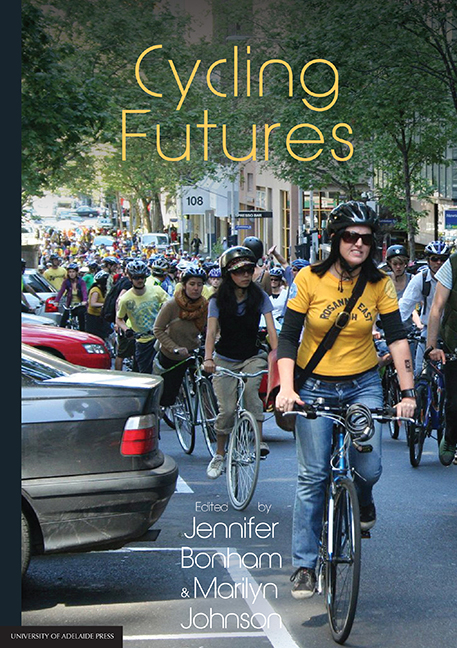Book contents
- Frontmatter
- Contents
- Preface
- Editors
- Contributors
- PART I Current challenges
- PART II Strategies for change
- 9 Gender and cycling: Gendering cycling subjects and forming bikes, practices and spaces as gendered objects
- 10 Making (up) the child cyclist: Bike Ed in South Australia
- 11 More than a message: Producing cyclists through public safety advertising campaigns
- 12 Spaces for cycling
- 13 Off-road cycling infrastructure
- 14 Teaching Australian civil engineers about cycling
- 15 What should planners know about cycling?
- 16 Skilling landscape architects and urban designers for design of bicycle parking and network facilities
- 17 Cycling and Australian law
15 - What should planners know about cycling?
from PART II - Strategies for change
Published online by Cambridge University Press: 25 July 2017
- Frontmatter
- Contents
- Preface
- Editors
- Contributors
- PART I Current challenges
- PART II Strategies for change
- 9 Gender and cycling: Gendering cycling subjects and forming bikes, practices and spaces as gendered objects
- 10 Making (up) the child cyclist: Bike Ed in South Australia
- 11 More than a message: Producing cyclists through public safety advertising campaigns
- 12 Spaces for cycling
- 13 Off-road cycling infrastructure
- 14 Teaching Australian civil engineers about cycling
- 15 What should planners know about cycling?
- 16 Skilling landscape architects and urban designers for design of bicycle parking and network facilities
- 17 Cycling and Australian law
Summary
Introduction
Planners have traditionally played an important co-ordination role in planning for urban development by bringing together a range of disciplinary knowledges, including transport knowledges, in determining the suitability of particular forms of development in particular locations. While this has increased planners’ understanding of the links between land use, transport and a host of related fields, it has not been conducive to planners seeking out and developing specialised knowledge of particular modes of transport such as cycling. Land use planners in particular have relied on the advice and direction of those with specialised knowledge of transport — namely, transport planners and traffic engineers — in making decisions about cycling without seeking out and actively engaging with knowledges of cycling as a specific mode of urban transport with specific requirements within urban environments.
While the importance of the engineering knowledges that transport planners and traffic engineers use to underpin their practice should not be denied (see Rose, Chapter Fourteen, this volume), there is increasing evidence to suggest that there is a lot more that planners need to know in order to properly plan for cycling as a mode of urban transport. The recent spate of integrated land use and transport initiatives developed across Australia and New Zealand (Auckland Regional Transport Authority, 2009; Government of South Australia, 2013; Government of Victoria, 2010; New South Wales Government, 2012) attests to the growing recognition of how the nexus between land use and transport planning provides an important mechanism to reshape urban development towards more compact and sustainable urban forms. These initiatives seek to densify the existing urban footprint while boosting the provision of public transport and encouraging active travel modes such as walking and cycling.
In embracing the notion of active travel and its role in creating more sustainable and healthy cities (see Department of Infrastructure and Transport, 2013; Government of South Australia, 2011b; National Heart Foundation of Australia (Victorian Division), 2004; Planning Institute of Australia, Heart Foundation, & Australian Local Government Association, 2009), planners will not only need to broaden their knowledge of specific modes of transport, but also recognise the diverse and sometimes conflicting needs of urban travellers in order to enable greater participation in cycling.
- Type
- Chapter
- Information
- Cycling Futures , pp. 321 - 356Publisher: The University of Adelaide PressPrint publication year: 2015



